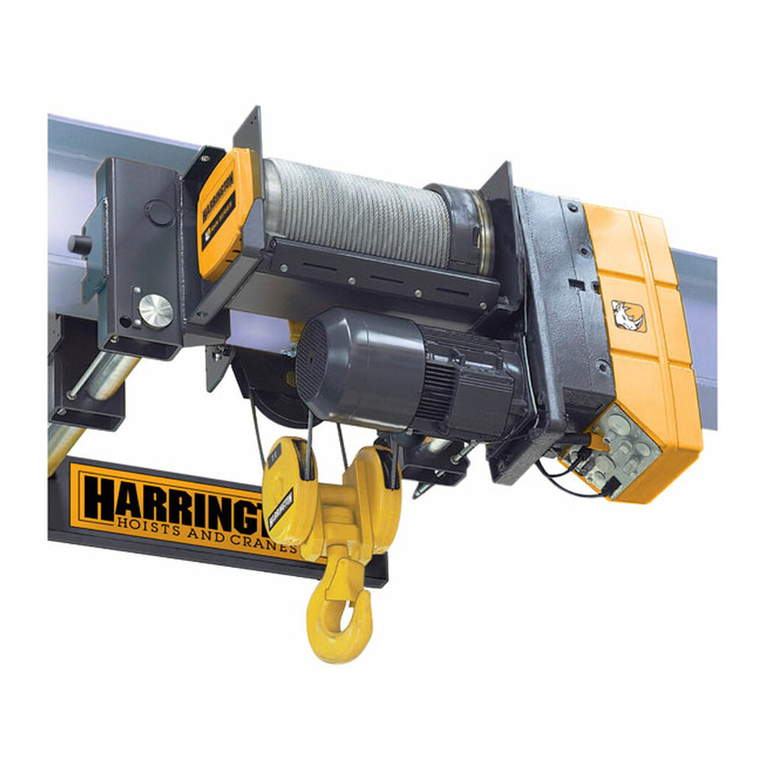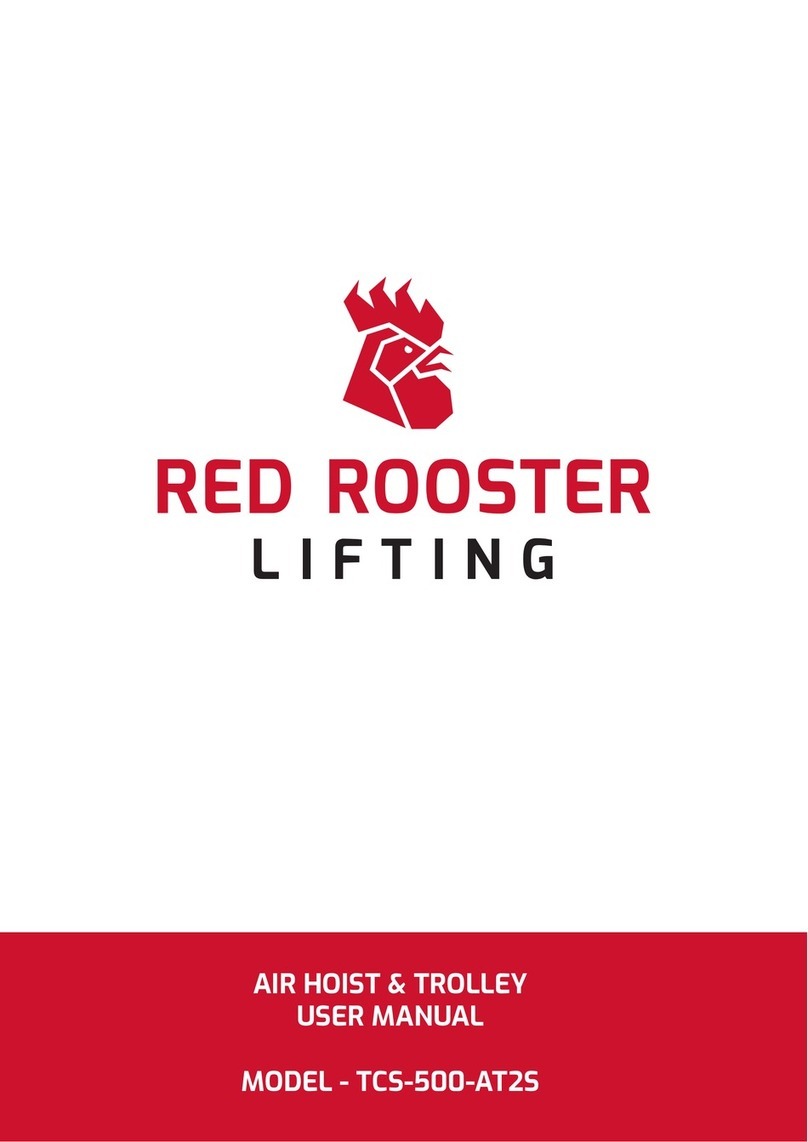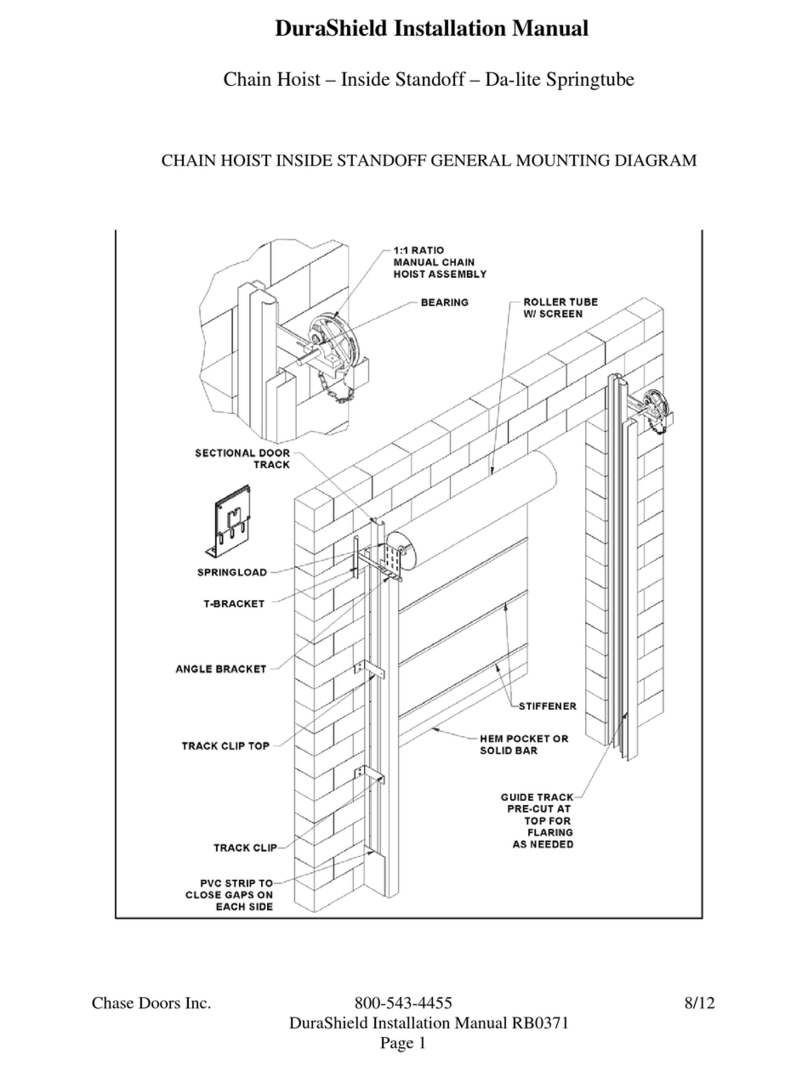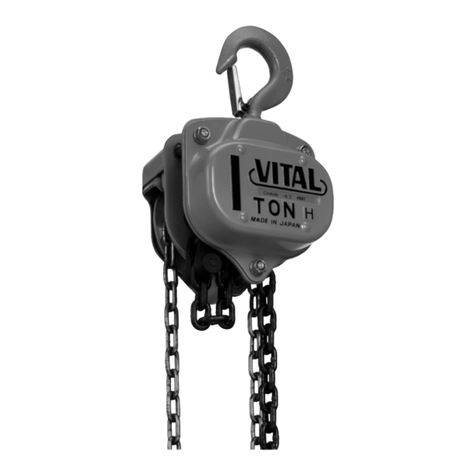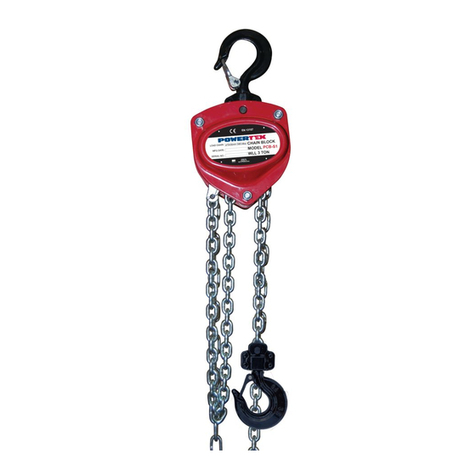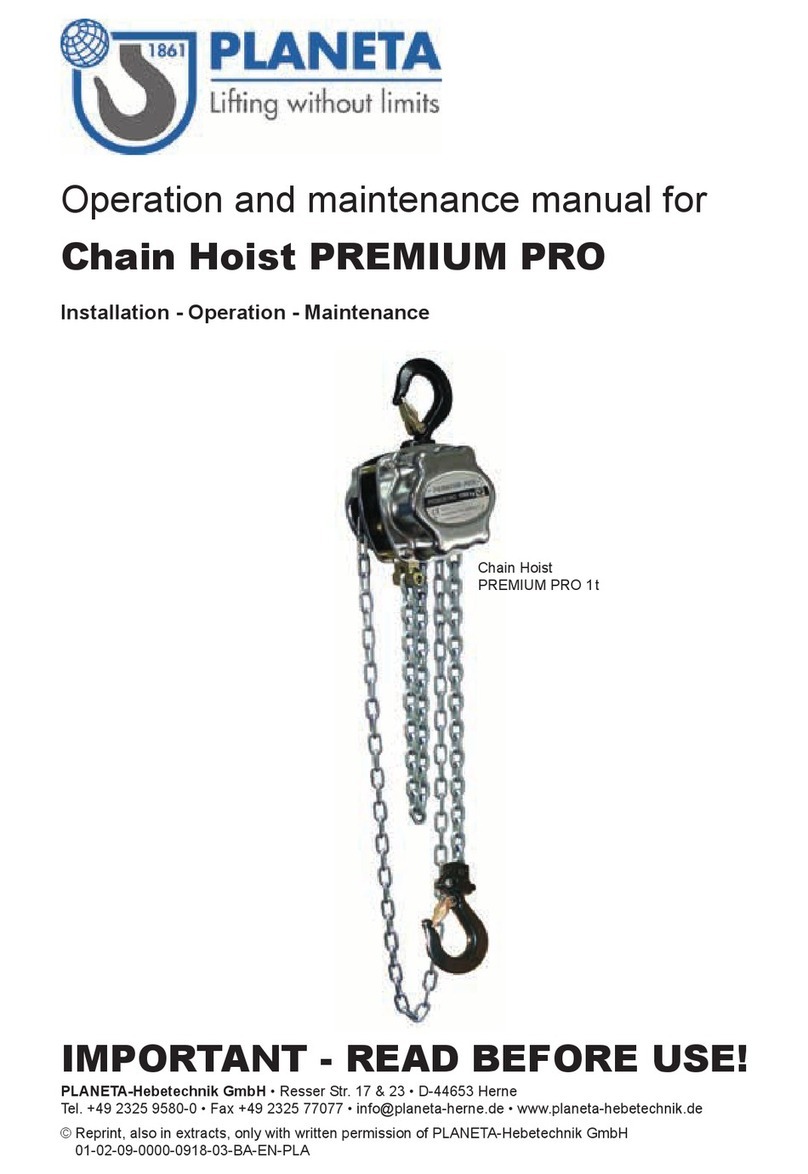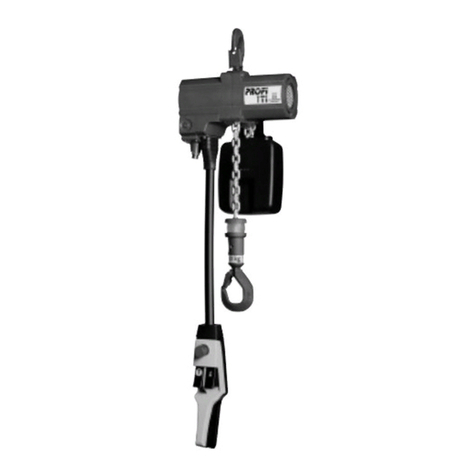Harrington Hoists ER Series Configuration guide

Owner's Manual Supplement
ELECTRIC
CHAIN HOIST
ER and NER
SERIES
CYLINDER
CONTROL MODEL
1/8 and 1/4 Ton Capacities
Code, Lot and Serial Number
WARNING
This equipment should not be installed, operated or
maintained by any person who has not read and understood
all the contents of this manual. Failure to read and comply
with the contents of this manual can result in serious bodily
injury or death, and/or property damage.
EFFECTIVE: February 18, 2002

2
IMPORTANT INFORMATION ON HOW TO USE THIS MANUAL
This OWNER’S MANUAL SUPPLEMENT is intended for use in combination with the “Owner’s Manual for
Electric Chain Hoist ER and NER Series 1/8 through 5 Ton Capacity”. Refer to the Table of Contents below to
determine the location(s) of information pertaining to your hoist. References to the “Owner’s Manual for Electric Chain
Hoist ER and NER Series 1/8 through 5 Ton Capacity” will be designated by the use of the acronym “EROM”.
Table of Contents
Section Page Number
1.0 Important Information and Warnings ……………………………………………………………….. EROM
1.1 Terms and Summary EROM
1.2 Warning Tags and Labels EROM
2.0 Technical Information…………………………………………………………………………….…………. 4
2.1 Specifications 4
2.2 Dimensions 5
3.0 Preoperational Procedures ……………………………………………………….………. 6 and EROM12
3.1 Fill Gear Box with Oil EROM
3.2 Chain 6
3.3 Mounting Location 7
3.4 Mounting the Hoist 7
3.5 Electrical Connections 7
3.6 Preoperational Checks and Trial Operation EROM
4.0 Operation ……………………………………………………………………………………… 9 and EROM
4.1 Introduction EROM
4.2 Shall’s and Shall Not’s for Operation EROM
4.3 Hoist Controls 9

3
Section Page Number
5.0 Inspection ……………………………………………………………………………………………...EROM
5.1 General EROM
5.2 Inspection Classification EROM
5.3 Frequent Inspection EROM
5.4 Periodic Inspection EROM
5.5 Occasionally Used Hoists EROM
5.6 Inspection Records EROM
5.7 Inspection Methods and Criteria EROM
6.0 Maintenance & Handling ……………………………………………………………………………. EROM
6.1 Count/Hour Meter EROM
6.2 Lubrication EROM
6.3 Motor Brake EROM
6.4 Load Chain EROM
6.5 Friction Clutch and Mechanical Load Brake with Friction Clutch EROM
6.6 Storage EROM
6.7 Outdoor Installation EROM
7.0 Troubleshooting ……………………………………………………………………………………… EROM
8.0 Material Safety Data Sheets ………………………………………………………………………… EROM
8.1 ER Model Gear Box Oil EROM
8.2 NER Model Gear Box Oil EROM
9.0 Warranty ……………………………………………………………………………………………… EROM
10.0 Parts List ……………………………………………………………………………………... 10 and EROM

4
2.0 Technical Information
2.1 Specifications
2.1.1 Product Code
2.1.2 ER and NER Models - Harrington ER series hoist are available in two versions, the ER and NER.
These two versions are equipped with different options as standard equipment. The NER has a friction
clutch mechanism that provides over winding protection. The ER has a mechanical load brake/friction
clutch combination and an electronic count/hour meter in the control circuit. Refer to Figure 2-1 for the
visual differences between the ER and NER.
Figure 2-1 Identifying ER verses NER Models
2.1.3 Operating Conditions and Environment
Temperature range: -4° to +104°F (-20° to +40°C)
Humidity: 85% or less
Enclosure Rating: Hoist Meets IP 55, Cylinder Meets IP44
Supply Voltage: Standard 208-230/460V-3-60, Optional 575V-3-60, Special Voltages Available
Single Speed Dual Speed
ASME Duty Classification: H4 H4
Intermittent Duty Rating: 60% ED
360 starts per hour
40/20% ED
120/240 starts per hour
Short Time Duty Rating: 60 min. 30/10 min.

5
Table 2-1 Hoist Specifications
Lifting Motor 3 Phase 60 Hz
Rated Current
(amps)
Cap.
(Tons)
Product
Code
Standard
Lift
(ft)
Lifting
Speed
(ft/min) Output
(Hp) @208V
– 230V @460V
Load
Sheave
Pockets
Load
Chain
Diameter
(mm)
X
Chain
Fall
Lines
Net
Weight
(lbs)
1/8 ER001HCC 6 57 0.75 4.2 2.1 5 5.0 x 1 68
Single
Speed 1/4 ER003SCC 6 39 0.75 4.2 2.1 5 5.0 x 1 68
1/8 ER001HDCC 6 58/19 0.6/0.2 2.9/2.4 1.5/1.2 5 5.0 X 1 79
Dual
Speed 1/4 ER003SDCC 6 29/10 0.6/0.2 2.9/2.4 1.5/1.2 5 5.0 X 1 79
2.2 Dimensions
Table 2-2 Hoist Dimensions
Cap.
(Tons)
Product
Code
Headroom
C
D
(in)
a
(in)
b
(in)
d
(in)
e
(in)
f
(in)
g
(in)
h
(in)
i
(in)
1/8 ER001HCC 40.6 17.7 21.1 13.0 10.4 10.7 10.4 1.0 4.0 3.9
Single
Speed 1/4 ER003SCC 40.6 17.7 21.1 13.0 10.4 10.7 10.4 1.0 4.0 3.9
1/8 ER001HDCC 40.6 17.7 22.2 13.0 10.4 11.9 10.4 1.0 4.0 3.9
Dual
Speed 1/4 ER003SDCC 40.6 17.7 22.2 13.0 10.4 11.9 10.4 1.0 4.0 3.9
Table 2-3 Hook Dimensions
Capacity
Code Hook** a
(in)
b
(in)
c
(in)
d
(in)
e
(in)
g
(in)
T 1.1 0.7 0.9 0.7 1.4 1.1
001H, 003S
B 0.8 0.5 0.7 0.5 1.4 1.0

6
3.0 Preoperational Procedures
3.2 Chain
3.2.1 Chain Components – Refer Figure 3-1 and ensure that stoppers and cushion rubbers are in the
correct location and properly installed. Never operate the hoist with incorrect, missing or
damaged chain components.
Figure 3-1 Chain Component Location
3.2.2 Chain Container – Install the chain container on the hoist body as shown in Figure 3-2. To place the
chain into the chain container, feed the chain into the chain container beginning with the free end. Take
care to avoid twisting or tangling the chain. NEVER put all the chain into the container at once. Lumped
or twisted chain may jam against the hoist body activating the friction clutch and potentially damaging
the chain.

7
Figure 3-2 Chain Container Installation
3.3 Mounting Location
3.3.1 WARNING Prior to mounting the hoist ensure that the suspension and it supporting
structure are adequate to support the hoist and its loads. If necessary consult a professional that
is qualified to evaluate the adequacy of the suspension location and its supporting structure.
3.3.2 NOTICE See Section 6.7 of the EROM for outdoor installation considerations.
3.4 Mounting the Hoist
3.4.1 Manual Trolley - Follow instructions in Owner’s Manual provided with the trolley.
3.4.2 Motorized Trolley – Cylinder control model hoists are NOT intented to be used with motorized trolleys.
3.4.3 Hook Mounted to a Fixed Location - Attach the hoist’s top hook to the fixed suspension point.
3.4.4 CAUTION Mount the hoist at a height that will allow the operator to maintain a clearance of at
least 4 inches between the Cushion Rubber and the hoist body during operation.
3.4.5 WARNING Ensure that the fixed suspension point rests on the center of the hook’s saddle and
that the hook’s latch is engaged.
3.5 Electrical Connections
3.5.1 CAUTION Ensure that the voltage of the electric power supply is proper for the hoist.
3.5.2 DANGER Before proceeding, ensure that the electrical supply for the hoist has been de-
energized (disconnected). Lock out and tag out in accordance with ANSI Z244.1 “Personnel Protection
-Lockout/Tagout of Energy Sources”.
3.5.3 Coiled Control Cable - The Coiled Control Cable connects to the hoist via a 5-pin (5P) or 8-pin (8P)
Plug and Socket. Make this connection as follows:
§Refer to Figure 3-3.
§Insert the 5P/8P Plug into the 5P/8P Socket on the hoist and hand tighten the Screw Coupling.

8
3.5.4 Power Supply Cable Hoist Connection – The Power Supply Cable connects to the hoist via a 4-pin
(4P) plug and socket. Make this connection as follows:
§Refer to Figure 3-3.
§Insert the 4P plug of the Power Supply Cable into the 4P Socket on the hoist and hand tighten the
screw coupling.
§Install the Cable Support Arm (pre-installed on the Power Supply Cable) on to the Socket Holder
using the pre-installed Machine Screws and Lock Washers.
Use care to avoid twisting or kinking the Power Supply Cable.
3.5.5 Power Supply Cable Installation – If the hoist is hook mounted to a fixed support ensure that the
Power Supply Cable is properly installed and supported between the hoist and the electrical
power supply.
If the host is installed on a manual trolley, then the Power Supply Cable must be installed along the
beam that the trolley runs on. For curved beams a special cable suspension system will be
needed, and this instruction does not apply. For straight beams install the Power Supply Cable as
follows:
§Install a guide wire system parallel to the beam.
§For a manual trolley the guide wire should be positioned slightly outside the hoist's Cable
Support as shown in Figure 3-3.
§Use the Cable Trolleys supplied with the hoist to suspend the Power Supply Cable from the
guide wire. Space the Cable Trolleys every 5 feet.
Figure 3-3 Coiled Control Cable and Power Supply Cable Connections
3.5.6 Connection to Electrical Power Source - The red, white, and black wires of the Power Supply Cable
should be connected to an Electric Power Disconnect Switch or Circuit Breaker. This connection
should be made so that the hoist is phased properly. Refer to Section 3.6.11 of the EROM for
instructions on how to check for correct power supply phase connection.
3.5.7 Fuse/Breaker Capacity -The hoist's power supply should be equipped with overcurrent protection such
as fuses, which should be selected for 110% to 120% of total listed full load amperage, and should be
dual element time-delay fuses. Refer to the motor nameplate for the full load amperage draw.
3.5.8 DANGER Grounding - An improper or insufficient ground connection creates an electrical
shock hazard when touching any part of the hoist or trolley. In the Power Supply Cable the ground wire
will be either Green with Yellow stripe or solid Green. It should always be connected to a suitable
ground connection. Do not paint the trolley wheel running surfaces of the beam as this can affect
grounding.

9
4.0 Operation
4.3 Hoist Controls
4.3.1 Single Speed Hoists – Firmly hold the black Grip on the cylinder control. Slide the Up/Down Switch
Operator up to raise the load or down to lower the load as shown in Figure 4-1. To stop the hoist slide
the Up/Down Switch Operator back to the middle position.
4.3.2 Dual Speed Hoists – Select high or low speed using the Speed Selector Switch. Lights ajacecnt to the
Speed Selector Switch indicate if low or high speed is selected. Slide the Up/Down Switch Operator up
to raise the load or down to lower the load Figure 4-1. To stop the hoist slide the Up/Down Switch
Operator back to the middle position.
4.3.3 CAUTION Make sure the motor completely stops before reversing direction.
Single Speed Dual Speed
Figure 4-1 Cylinder Control Operation

10
10.0 Parts List
Figure 10-1 Cylinder Control Parts

11
Figure
No. Part Name Parts per
Hoist Part Number
1Detachable Hook Assy 1CD1BI1011
2Latch Assembly 1CF071005
3Detachable Fitting E 1E2D5041125
4Flat Head Screw 19096528
5Chain Pin 1M3041005
6Slotted Nut 1M3049005
7Split Pin 19009402
8Cushion Rubber 2E5FE003S9046
9Stopper Assembly 2ES1045003
S 1 C10013H1020
10 Cylinder Switch Set D 1 C20013H1020
11 Truss-Head Screw 1TRUSSM4X10
5P Plug S 1 ES613003
12 8P Plug D 1 ESM538010
13 Warning Tag 1WTAG7
14 Cable Holder A 1CD1BS9750
15 Cable Holder B 1CD1BS9751
16 Cable Tie 29006602
17 Machine Screw w/Spring
Washer 4MS554010
18 Socket Bolt 19091259
19 Lever Nut 1ES855003
20 Limit Lever Pin Assembly 1CD1BS2757
21 Spacer 1CD1BS9758
5P Socket S 1 CD1BS1564
22 8P Socket D 1 CD1BB1564
23 Chain Container Kit 1PBK-B
24 Chain Container Spring 1ER1BS9416
25 Socket Bolt 1J1BE10816513
26 Lever Nut 1ES857005S

www.harringtonhoists.com
Harrington Hoists, Inc. Harrington Hoists – Western Division
401 West End Avenue 2341 Pomona Rincon Rd. #103
Manheim, PA 17545-1703 Corona, CA 92880-6973
Phone: 717-665-2000 Phone: 909-279-7100
Toll Free: 800-233-3010 Toll Free: 800-317-7111
Fax: 717-665-2861 Fax: 909-279-7500
ERCYLSup
This manual suits for next models
5
Table of contents
Other Harrington Hoists Chain Hoist manuals
Popular Chain Hoist manuals by other brands
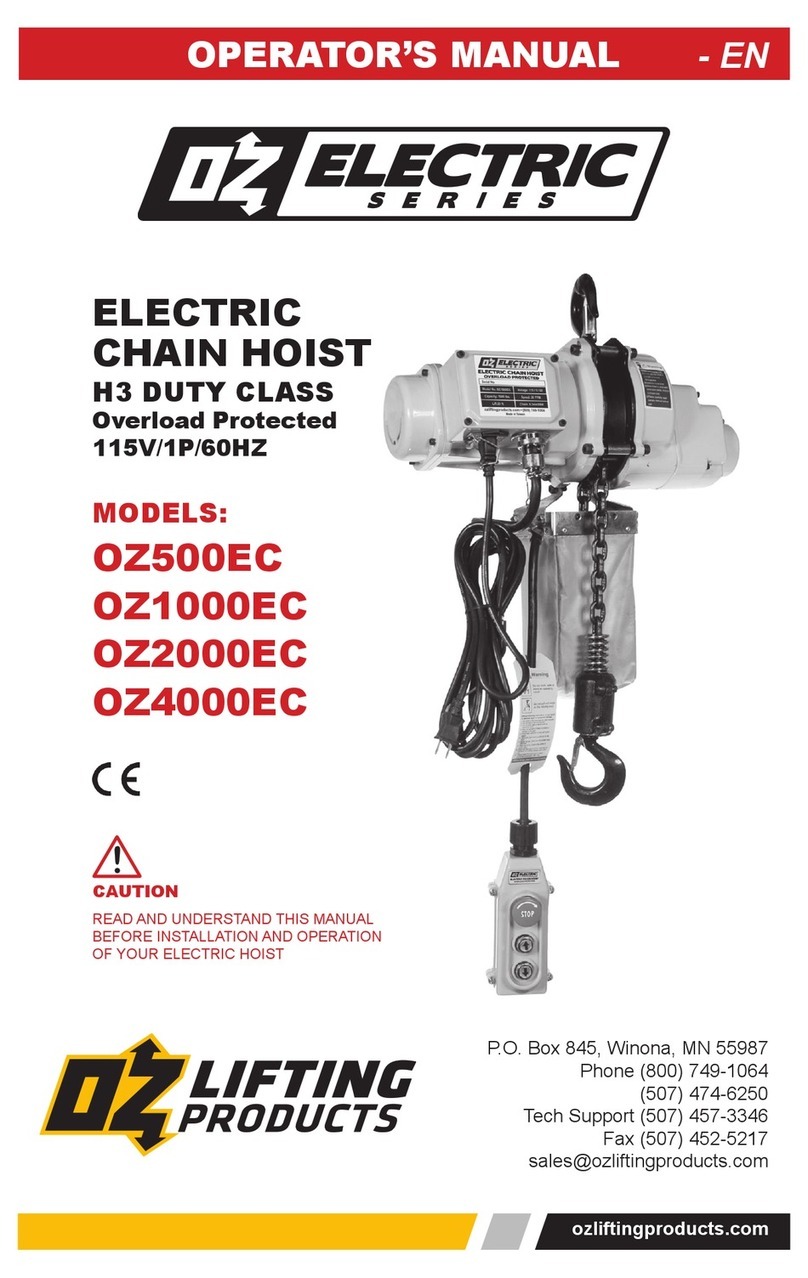
OZ Lifting Products
OZ Lifting Products OZ500EC Operator's manual
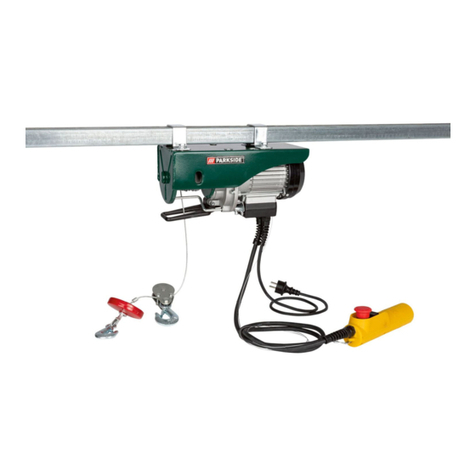
Parkside
Parkside PSZ 250 A1 Operation and safety notes
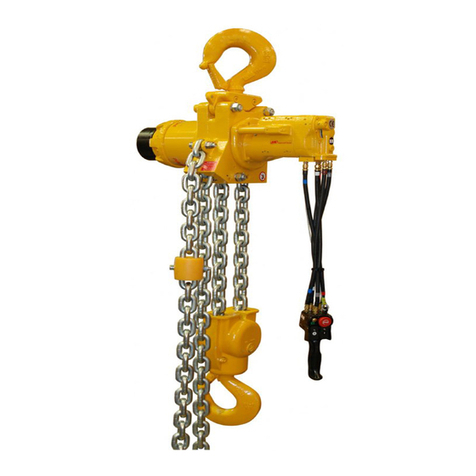
Ingersol Rand
Ingersol Rand LC2A Series Product information

Silverline
Silverline 442463 manual

Austlift
Austlift 915303 Service manual
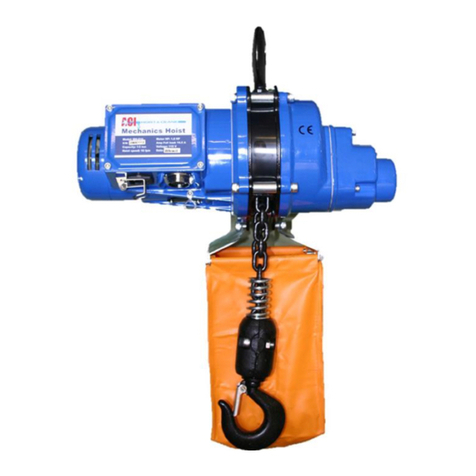
ACI Hoist & Crane
ACI Hoist & Crane MH Operation manual
